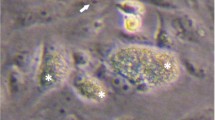Abstract
Liposomes are used as carriers of drugs intended to manipulate macrophage functions. The normal in vivo fate of liposomes is phagocytosis, followed by phospholipase-mediated disruption of their phospholipid bilayers and intracellular release of their contents. Using this method for intracellular delivery of drugs, we have developed an approach for in vivo depletion of macrophages. Phagocytosis also forms a major feature of parasitic amoebae. In the present experiments, we investigated whether amoebae could be killed using the same approach (liposome-mediated “suicide” of amoebae). The results confirm that liposomes are ingested byEntamoeba invadens cultured under routine laboratory conditions. From various chelator molecules and their metalion complexes that were active in the liposome-mediated elimination of macrophages, Cu-ethylenediaminetetraacetic acid (EDTA) complexes appeared to be the most efficacious compounds in the elimination ofE. invadens.
Similar content being viewed by others
References
Aramaki Y, Tomizawa H, Hara T, Yachi K, Kikuchi H, Tsuchiya S (1993) Stability of liposomes in vitro and their uptake by rat Peyer's patches following oral administration. Pharm Res 10: 1228–1235
Claassen E (1992) Post-formation fluorescent labelling of liposomal membranes. In vivo detection, localisation and kinetics. J Immunol Methods 147: 231–240
Graf E, Mahoney JR, Bryant RG, Eaton JW (1984) Iron-catalyzed hydroxyl radical formation. Stringent requirement for free iron coordination site. J Biol Chem 259: 3620–3624
Gregoriadis G (1988) Liposomes as drug carriers: recent trends and progress. John Wiley & Sons, Chichester
Huitinga I, Van Rooijen N, De Groot CJA, Uitdehaag BMJ, Dijkstra CD (1990) Suppression of experimental allergic encephalomyelitis in Lewis rats after elimination of macrophages. J Exp Med 172: 1025–1033
Montfort I, Olivos A, Perez-Tamayo R (1993) Phagocytosis and proteinase activity are not related to pathogenicity ofEntamoeba histolytica. Parasitol Res 79: 160–162
Orozco E, Guarneros G, Martinez-Palomo A, Sanchez T (1983)Entamoeba histolytica: phagocytosis as a virulence factor. J Exp Med 158: 1511–1521
Petri WA, Clark CG, Braga L, Mann BJ (1993) International seminar on amebiasis. Parasitol Today 9: 73–76
Tsutsumi V, Ramirez-Rosales A, Lanz-Mendoza H, Shibayama M, Chavez B, Rangel-Lopez E, Martinez-Palomo A (1992)Entamoeba histolytica: erythrophagocytosis, collagenolysis and liver abscess production as virulence markers. Trans Soc Trop Med Hyg 86: 170–174
Umezawa F, Eto Y (1988) Liposome targeting to mouse brain: mannose as a recognition marker. biochem Biophys Res Commun 153: 1038–1046
Van Rooijen N (1989) The liposome mediated macrophage “suicide” technique. J Immunol Methods 124: 1–6
Van Rooijen N (1992) Liposomes as an “in vivo” tool to study and manipulate macrophage function: 41st Forum in immunology. Res Immunol 143: 177–256
Van Rooijen N, Poppema A (1992) Efficacy of various water-soluble chelator molecules in the liposome-mediated macrophage “suicide” technique. J Pharmacol Toxicol Methods 28: 217–221
Author information
Authors and Affiliations
Rights and permissions
About this article
Cite this article
van Rooijen, N., Bakker, J., Sanders, A. et al. Killing ofEntamoeba invadens using liposome-encapsulated drugs. Parasitol Res 81, 258–261 (1995). https://doi.org/10.1007/BF00937119
Received:
Accepted:
Issue Date:
DOI: https://doi.org/10.1007/BF00937119




